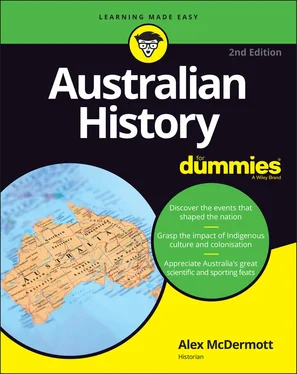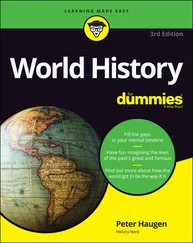In 1939, Australians faced up to another world war, but this time one fought not only on faraway battlefields (as World War I had been) but also much closer to home. Japan’s downward thrust meant that, for the first time in its history, Australia felt itself to be directly menaced with possible invasion. Darwin and other northern towns were repeatedly bombed but Britain, its hands full defeating Nazi Germany, was unable to send much in the way of help.
Luckily, America’s interests and Australia’s coincided: America needed a geographic base from which to launch a counteroffensive against Japan, and Australia needed the reassuring presence of a great and powerful ally. Australia geared its economy up to full capacity, converting all possible industries to war production. (See Chapter 16for more on Australia’s involvement in World War II and events back home.)
As the tide of the war turned, the Curtin Government began preparing postwar reconstruction plans. Along with implementing a bold new immigration scheme (for the first time taking in large numbers of European immigrants as well as those from Britain), considerable economic and social progress was made (see Chapter 17). This laid the groundwork that helped sustain an economic boom that proved second only to the long boom of the 19th century for duration (see Chapter 18).
Prosperity unleashed a new generation — the postwar baby boomers — onto the world, coinciding with a social revolution in the 1960s. This younger generation had grown up in an era of prosperity and increasing material affluence — an experience quite unlike the Depression and war years in which their parents had reached maturity. The Beatles, miniskirts and tie-dye psychedelia — you have the 1960s to thank for them. The 1960s also spawned a series of social movements, including:
Vietnam War protests: Many in the baby-boomer generation refused point-blank to serve as conscripts or soldiers in the Vietnam War, which Australia had entered in 1962.
Calls for the end of the White Australia Policy: This policy was aimed at excluding non-whites from immigration into Australia (under the old social homogeneity argument or, as Labor minister Arthur Calwell unfortunately joked, the argument that ‘Two Wongs don’t make a White’.) By the 1960s, the policy was becoming increasingly odious to newly independent non-white nations. The policy was progressively dismantled from 1966.
Campaigns for civil rights for Aboriginals: Inspired by the civil rights movement for African Americans in the US, Indigenous Australians began agitating to have all constitutional bars against their full recognition as Australian citizens removed.
Women’s rights campaigns: Liberated by access to a recently developed contraceptive (‘the pill’) and ‘no-fault’ divorce, Australian women began calling for equal rights, including equal payment for work done, the right to work after getting married or having children, and the removal of old segregation rules (such as those that fined pub owners for serving women in the front bar of pubs) that were starting to appear, quite frankly, a little archaic.
See Chapter 19for more on the changes wreaked during the 1960s and 1970s in Australia.
Breaking Down the Fortress Australia Mentality
The ambition for pushing through and instituting great waves of social change came to a head under the government of Labor leader Gough Whitlam in 1972 to 1975 (see Chapter 19). Unfortunately for Gough, however, the economic good times of the postwar boom that had been sustaining the plans for social change came to an end during his prime ministership. The recession destroyed his government, as it did his successor, Liberal Malcolm Fraser.
The challenge of fixing the economic problems — including the special guest stars of high inflation, rising unemployment and declining industries — was so great that it took a concerted revision and ultimate termination of the original Fortress Australia economic policies first implemented early in the 1900s. This was a long period of sustained and largely unquestioned economic orthodoxy to up-end, but up-ended it was.
At the same time, another revolution was taking place — this one with a more multicultural flavour.
By the end of the 1980s, Australia had begun winding back tariffs used to protect uncompetitive industries. It had also opened up the financial market, and allowed the Australian dollar to ‘float’ and find its own level of value on international exchange markets rather than being kept fixed at an artificial and government-maintained level.
 The ‘closed shop’ era was over, and in the early 1990s, Australia experienced acute economic trauma during what economists glibly labelled the ‘structural readjustment phase’, a phase that included the worst recession of the postwar era. But Australia emerged from the recession ready to take advantage of a new period of economic expansion, prosperity and growth. Thanks to the various economic reforms introduced through the 1980s and 1990s, Australia surprised many by weathering the Asian financial crisis of the late 1990s the best of any country in the region. It was also well placed to take advantage of the China boom of the 2000s, and sail serenely through the global financial crisis of 2008. (See Chapter 20for more on the changes introduced through the 1980s, and their short-term effects.)
The ‘closed shop’ era was over, and in the early 1990s, Australia experienced acute economic trauma during what economists glibly labelled the ‘structural readjustment phase’, a phase that included the worst recession of the postwar era. But Australia emerged from the recession ready to take advantage of a new period of economic expansion, prosperity and growth. Thanks to the various economic reforms introduced through the 1980s and 1990s, Australia surprised many by weathering the Asian financial crisis of the late 1990s the best of any country in the region. It was also well placed to take advantage of the China boom of the 2000s, and sail serenely through the global financial crisis of 2008. (See Chapter 20for more on the changes introduced through the 1980s, and their short-term effects.)
Opening up the borders (mostly)
At the same time as the economic revolution, a sustained and at times ferocious debate was taking place over Australia’s cultural direction. When the White Australia Policy had been dismantled in the 1960s, it was done with loud public reassurances that ‘social homogeneity’ continued to be the key ambition informing immigration policy. Australia was welcoming immigrants from many diverse and new parts of the world, but the job of the immigrants was to adjust and assimilate. The thought that Australia could be genuinely enriched by these diverse new arrivals was slow to dawn in policy circles.
The big turnaround took place in the late 1970s, when Malcolm Fraser launched a policy of multiculturalism and also began accepting large numbers of predominantly Asian migrants — refugees from the Vietnam War (see Chapter 20). The idea behind multiculturalism — that it was okay for immigrants to want to retain their own culture while living in Australia, and that Australia might actually benefit from these cultures — was a shift in Australia’s approach to the world and its attitude to itself so profound as to be seismic.
By the late 1980s, the policy of multiculturalism was provoking murmurs of discontent. A report to the Hawke Labor Government concluded that the pendulum had now swung too far in the other direction — that many people were worried that embracing multiculturalism and diversity meant valuing and esteeming all other cultures and heritages but downgrading and devaluing Australia’s own, the core British–Australian culture that had provided all the building blocks for modern Australia.
 The tensions came to flashpoint in the late 1990s, when resentment against the economic changes of the 1980s, the recession of the late 1980s and early 1990s, and suspicion about the influx of new immigrants coalesced into support for Pauline Hanson’s ‘One Nation’ political movement. This movement combined nostalgia for the certainties of old Australia with the rejection of economic and social revolutions refashioning Australia. In the short-term it was a short-lived phenomenon, dissipating as economic circumstances improved and something resembling boom conditions returned to Australian life for the first time in 30 years. But it was also a harbinger of some of the debates and divisions which would challenge Australia in the 21st century as well.
The tensions came to flashpoint in the late 1990s, when resentment against the economic changes of the 1980s, the recession of the late 1980s and early 1990s, and suspicion about the influx of new immigrants coalesced into support for Pauline Hanson’s ‘One Nation’ political movement. This movement combined nostalgia for the certainties of old Australia with the rejection of economic and social revolutions refashioning Australia. In the short-term it was a short-lived phenomenon, dissipating as economic circumstances improved and something resembling boom conditions returned to Australian life for the first time in 30 years. But it was also a harbinger of some of the debates and divisions which would challenge Australia in the 21st century as well.
Читать дальше

 The ‘closed shop’ era was over, and in the early 1990s, Australia experienced acute economic trauma during what economists glibly labelled the ‘structural readjustment phase’, a phase that included the worst recession of the postwar era. But Australia emerged from the recession ready to take advantage of a new period of economic expansion, prosperity and growth. Thanks to the various economic reforms introduced through the 1980s and 1990s, Australia surprised many by weathering the Asian financial crisis of the late 1990s the best of any country in the region. It was also well placed to take advantage of the China boom of the 2000s, and sail serenely through the global financial crisis of 2008. (See Chapter 20for more on the changes introduced through the 1980s, and their short-term effects.)
The ‘closed shop’ era was over, and in the early 1990s, Australia experienced acute economic trauma during what economists glibly labelled the ‘structural readjustment phase’, a phase that included the worst recession of the postwar era. But Australia emerged from the recession ready to take advantage of a new period of economic expansion, prosperity and growth. Thanks to the various economic reforms introduced through the 1980s and 1990s, Australia surprised many by weathering the Asian financial crisis of the late 1990s the best of any country in the region. It was also well placed to take advantage of the China boom of the 2000s, and sail serenely through the global financial crisis of 2008. (See Chapter 20for more on the changes introduced through the 1980s, and their short-term effects.) The tensions came to flashpoint in the late 1990s, when resentment against the economic changes of the 1980s, the recession of the late 1980s and early 1990s, and suspicion about the influx of new immigrants coalesced into support for Pauline Hanson’s ‘One Nation’ political movement. This movement combined nostalgia for the certainties of old Australia with the rejection of economic and social revolutions refashioning Australia. In the short-term it was a short-lived phenomenon, dissipating as economic circumstances improved and something resembling boom conditions returned to Australian life for the first time in 30 years. But it was also a harbinger of some of the debates and divisions which would challenge Australia in the 21st century as well.
The tensions came to flashpoint in the late 1990s, when resentment against the economic changes of the 1980s, the recession of the late 1980s and early 1990s, and suspicion about the influx of new immigrants coalesced into support for Pauline Hanson’s ‘One Nation’ political movement. This movement combined nostalgia for the certainties of old Australia with the rejection of economic and social revolutions refashioning Australia. In the short-term it was a short-lived phenomenon, dissipating as economic circumstances improved and something resembling boom conditions returned to Australian life for the first time in 30 years. But it was also a harbinger of some of the debates and divisions which would challenge Australia in the 21st century as well.










